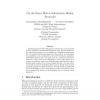Free Online Productivity Tools
i2Speak
i2Symbol
i2OCR
iTex2Img
iWeb2Print
iWeb2Shot
i2Type
iPdf2Split
iPdf2Merge
i2Bopomofo
i2Arabic
i2Style
i2Image
i2PDF
iLatex2Rtf
Sci2ools
JCS
2008
2008
On the Bayes risk in information-hiding protocols
Randomized protocols for hiding private information can be regarded as noisy channels in the information-theoretic sense, and the inference of the concealed information can be regarded as a hypothesis-testing problem. We consider the Bayesian approach to the problem, and investigate the probability of error associated to the MAP (Maximum Aposteriori Probability) inference rule. Our main result is a constructive characterization of a convex base of the probability of error, which allows us to compute its maximum value (over all possible input distributions), and to identify upper bounds for it in terms of simple functions. As a side result, we are able to improve the Hellman-Raviv and the Santhi-Vardy bounds expressed in terms of conditional entropy. We then discuss an application of our methodology to the Crowds protocol, and in particular we show how to compute the bounds on the probability that an adversary break anonymity.
| Added | 13 Dec 2010 |
| Updated | 13 Dec 2010 |
| Type | Journal |
| Year | 2008 |
| Where | JCS |
| Authors | Konstantinos Chatzikokolakis, Catuscia Palamidessi, Prakash Panangaden |
Comments (0)

